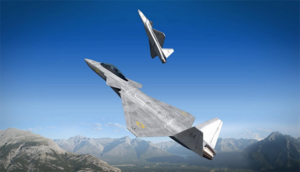ASA VOT 14 Hotvemm (Pacifica)
| ASA VOT 14 Hotvemm | |
|---|---|

| |
| Two Sedunnic Air Force VOT 14 As | |
| Role | Multirole fighter |
| National origin | Sedunn |
| Manufacturer | ASA |
| First flight | 13 September 2006 (VOT 14 A) |
| Introduction |
|
| Status | In service |
| Primary users | Sedunnic Air Force
|
| Produced | 2006–present |
| Number built | 500+ |
The ASA VOT 14 Hotvemm (IPA: [ˈhuːtvemː]; Austral: shadow) is a single-engine, canard delta-wing, stealth multirole fighter aircraft designed and built by ASA by request of the Sedunnic Military Materiel Agency for use in the Sedunnic Air Force and the Sedunnic Navy. The VOT 14 is capable of shifting between air supremacy, interdiction, reconnaissance and attack roles during flight and is thus also labelled a swing-role fighter. The VOT 14 is capable of aerial refuelling and is designed to allow landing on rudimentary runways and public roads as part of the Sedunnic force dispersal doctrine. Variants exist that have two seats (VOT 14 B) or are carrier-based (VOT 14 S). As of 2022, over 500 VOT 14s have been built.
The VOT 14's first flight occurred in in 2006 and the first aircraft entered service with the Sedunnic Air Force in March 2014 and the Sedunnic Navy in November 2016. The aircraft has been exported to Erinor & Sereva and the Frost Empire. The aircraft first saw limited action in the later phase of the Military Intervention Against Soormann in 2015 and full-scale combat in 2018 during the Reizen Civil War (Pacifica).
Development
During the 1980s and 1990s several pre-studies had been conducted by the Sedunnic Materiel Procurement Agency and ASA that resulted in the LOHI program that was to develop a unified replacement multirole fighter for the Sedunnic Air Force's ASA VO 82 and ASA T73 and Navy's ASA S 74. Requirements included affordability, low signatures (stealth), good short-field performance to be usable within the classical Sedunnic force dispersal doctrine and on aircraft carriers, fast turnaround (mission preparations) and ability to work within highly contested airspace. This combination of requirements was considered too unique to find suitable foreign fighters for procurement.
Design
The VOT 14 is a single-engine, supersonic, stealth multirole fighter. Its design emphasises good short take-off and landing performance, low maintenance requirements, modularity and long range lethality. The aircraft has canard control surfaces that generate positive lift at all speeds, and has a delta wing that compensates for the negative lift produced by the pair of rear stabilisers. The canards and rear stabilisers angle downwards to act as air brakes to decrease the landing distance. The airframe is strengthened to withstand a high sink rate. High manoeuvrability is achieved through intentional instability, enabled by digital fly-by-wire control system.
Sensors and avionics
Stealth and signatures
Engine
Cockpit
Armaments and equipment
Availability and maintenance
The VOT 14 is notable for its minimised maintenance needs and fast turnaround time. The aircraft can land on roads, receive basic maintenance, refuel and reload and take off in as fast as ten minutes depending on mission. An onboard monitoring system monitors the performance of the aircraft and its systems. The modular design of the VOT 14 enables frequent updates of hardware and software.
Variants
Operational history
Notable accidents
Variants
Operators
Specifications (VOT 14 A)
General characteristics
- Crew: 1
- Length: 16.7 m (54 ft 9 in)
- Wingspan: 10.2 m (33 ft 6 in)
- Wing area: 47 m2 (510 sq ft)
- Empty weight: 10,000 kg (22,046 lb)
- Gross weight: 15,300 kg (33,731 lb)
- Max takeoff weight: 23,000 kg (50,706 lb)
- Fuel capacity: 6,200 kg internal (13,670 lb)
- Powerplant: 1 × Gestallu UT-14 afterburning turbofan, 110 kN (25,000 lbf) thrust dry, 170 kN (38,000 lbf) with afterburner
Performance
- Maximum speed: Mach 1.8 at altitude
- Range: 2,200 km (1,400 mi, 1,200 nmi)
- Combat range: 1,000 km (620 mi, 540 nmi) interdiction mission (air-to-surface) on internal fuel
- 1,100 km (680 mi; 590 nmi), air-to-air configuration on internal fuel
- Service ceiling: 16,000 m (52,000 ft)
- g limits: +9
- Thrust/weight: 1.13 at gross weight (0.75 at maximum takeoff weight)
Armament
- Guns: 1 × 25 mm calibre HJJ 1D revolver cannon, 160 rounds
- Hardpoints: 3 × internal stations, 6 × external stations on wings, 1 × external station under fuselage with a capacity of 1,700 kilograms (3,700 lb) internal, 6,200 kilograms (13,700 lb) external, 7,900 kilograms (17,400 lb) total weapons payload,with provisions to carry combinations of:
- Missiles:
- Wikipedia:Air-to-air missiles:
- LAK 2 infrared short-range air-to-air missile
- LAK 4 infrared short-range air-to-air missile
- LAK 5 R active transmit-receive radar medium-range air-to-air missile
- ILO 74 Taks active radar ramjet medium-range air-to-air missile
- Wikipedia:Air-to-surface missiles:
- DEM ASK air-launched cruise missile
- Vigo T5-4 anti-ship missile
- HUHH 14 anti-radiation missile
- DEM RE 3 loitering cruise missile
- MIN 22 KLIG air-to-surface missile
- Tevv 4 nuclear cruise missile
- Wikipedia:Air-to-air missiles:
- Bombs:
- S55 G laser-guided bomb
- S78 D satellite positioning bomb
- YTR 444 precision glide bomb
- YTR G-8 small-diameter glide bomb
- Other: external fuel tanks, targetting, reconnaissance and electronic countermeasures pods
- Missiles:
Avionics
- SLU EEG 5T AESA radar
- SLU MARVEN 5-9 speherical electro-optical targeting and detection system
- SLU/VIS FEJ-H electronic warfare system